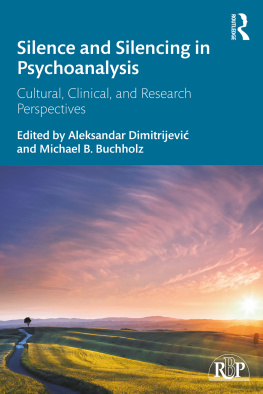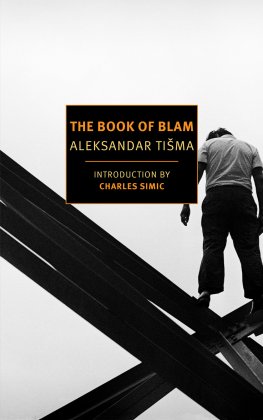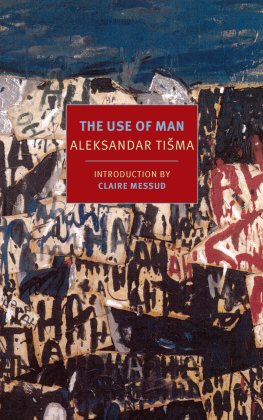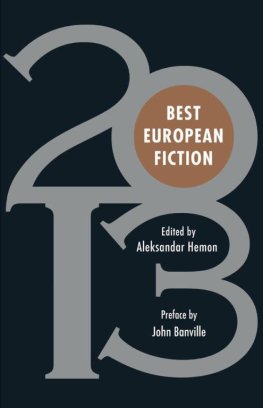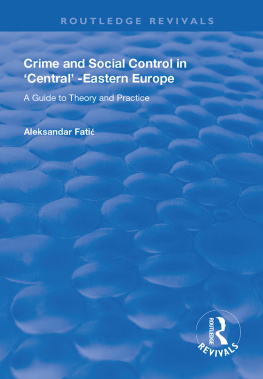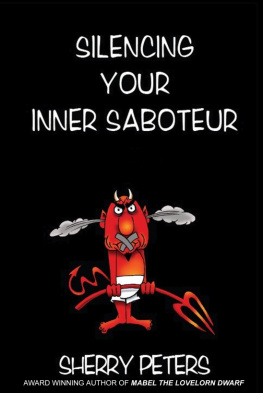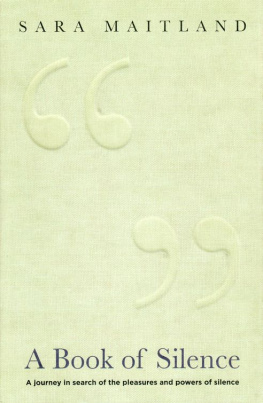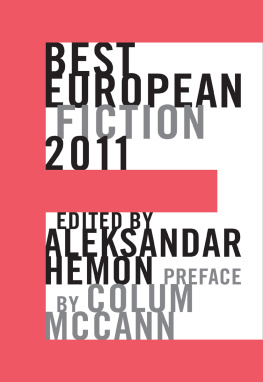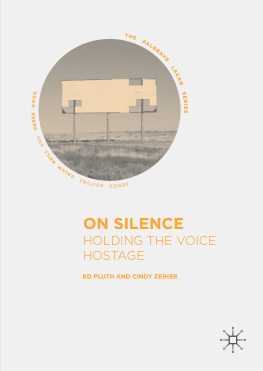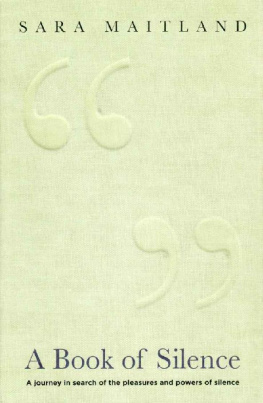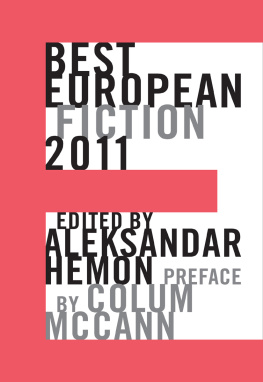Aleksandar Dimitrijević - Silence and Silencing in Psychoanalysis
Here you can read online Aleksandar Dimitrijević - Silence and Silencing in Psychoanalysis full text of the book (entire story) in english for free. Download pdf and epub, get meaning, cover and reviews about this ebook. year: 2020, publisher: Taylor and Francis, genre: Romance novel. Description of the work, (preface) as well as reviews are available. Best literature library LitArk.com created for fans of good reading and offers a wide selection of genres:
Romance novel
Science fiction
Adventure
Detective
Science
History
Home and family
Prose
Art
Politics
Computer
Non-fiction
Religion
Business
Children
Humor
Choose a favorite category and find really read worthwhile books. Enjoy immersion in the world of imagination, feel the emotions of the characters or learn something new for yourself, make an fascinating discovery.
- Book:Silence and Silencing in Psychoanalysis
- Author:
- Publisher:Taylor and Francis
- Genre:
- Year:2020
- Rating:5 / 5
- Favourites:Add to favourites
- Your mark:
- 100
- 1
- 2
- 3
- 4
- 5
Silence and Silencing in Psychoanalysis: summary, description and annotation
We offer to read an annotation, description, summary or preface (depends on what the author of the book "Silence and Silencing in Psychoanalysis" wrote himself). If you haven't found the necessary information about the book — write in the comments, we will try to find it.
Silence and Silencing in Psychoanalysis — read online for free the complete book (whole text) full work
Below is the text of the book, divided by pages. System saving the place of the last page read, allows you to conveniently read the book "Silence and Silencing in Psychoanalysis" online for free, without having to search again every time where you left off. Put a bookmark, and you can go to the page where you finished reading at any time.
Font size:
Interval:
Bookmark:

Silence and Silencing in Psychoanalysis
This book is the first comprehensive treatment in recent decades of silence and silencing in psychoanalysis from clinical and research perspectives, as well as in philosophy, theology, linguistics, and musicology.
The book approaches silence and silencing on three levels. First, it provides context for psychoanalytic approaches to silence through chapters about silence in phenomenology, theology, linguistics, musicology, and contemporary Western society. Its central part is devoted to the position of silence in psychoanalysis: its types and possible meanings (a form of resistance, in countertransference, the foundation for listening and further growth), based on both the work of the pioneers of psychoanalysis and on clinical case presentations. Finally, the book includes reports of conversation analytic research of silence in psychotherapeutic sessions and everyday communication. Not only are original techniques reported here for the first time, but research and clinical approaches fit together in significant ways.
This book will be of interest to all psychologists, psychoanalysts, and social scientists, as well as applied researchers, program designers and evaluators, educators, leaders, and students. It will also provide valuable insight to anyone interested in the social practices of silence and silencing, and the roles these play in everyday social interactions.
Michael B. Buchholz is professor of social psychology at the International Psychoanalytic University (IPU), Berlin, Germany. He is a psychologist and social scientist and a fully trained psychoanalyst. He is head of the Doctorate Program at IPU and chair of the social psychological department. He has published more than 20 books and more than 350 scientific papers on topics like analysis of therapeutic metaphors and therapeutic conversation, including the supervisory process, and he has contributed to psychoanalytic treatment technique, theory, and history. Michael has conducted conversation analytic studies on group therapy with sexual offenders about therapeutic contact scenarios, as well as on therapeutic empathy. His current interest is the study of therapeutic talk-in-interaction using Conversation Analysis.
Aleksandar Dimitrijevi, PhD , is a clinical psychologist and psychoanalyst. He works as a lecturer at the International Psychoanalytic University and in private practice in Berlin. He has given lectures, seminars, university courses, and conference presentations throughout Europe and in the United States of America. He is author of many conceptual and empirical papers about attachment theory and research, psychoanalytic education, and psychoanalysis and the arts, some of which were translated into German, Hungarian, Italian, Slovenian, Spanish, and Turkish. He has also edited or co-edited ten other books or special journal issues, the most recent of which is Ferenczis Influence on Contemporary Psychoanalytic Traditions (with Gabriele Cassullo and Jay Frankel, 2018).
RELATIONAL PERSPECTIVES BOOK SERIES
ADRIENNE HARRIS,
STEVEN KUCHUCK & EYAL ROZMARIN
Series Editors
STEPHEN MITCHELL
Founding Editor
LEWIS ARON
Editor Emeritus

The Relational Perspectives Book Series (RPBS) publishes books that grow out of or contribute to the relational tradition in contemporary psychoanalysis. The term relational psychoanalysis was first used by Greenberg and Mitchell to bridge the traditions of interpersonal relations, as developed within interpersonal psychoanalysis and object relations, as developed within contemporary British theory. But, under the seminal work of the late Stephen A. Mitchell, the term relational psychoanalysis grew and began to accrue to itself many other influences and developments. Various tributariesinterpersonal psychoanalysis, object relations theory, self psychology, empirical infancy research, feminism, queer theory, sociocultural studies, and elements of contemporary Freudian and Kleinian thoughtflow into this tradition, which understands relational configurations between self and others, both real and fantasied, as the primary subject of psychoanalytic investigation.
We refer to the relational tradition, rather than to a relational school, to highlight that we are identifying a trend, a tendency within contemporary psychoanalysis, not a more formally organized or coherent school or system of beliefs. Our use of the term relational signifies a dimension of theory and practice that has become salient across the wide spectrum of contemporary psychoanalysis. Now under the editorial supervision of Adrienne Harris, Steven Kuchuck and Eyal Rozmarin, the Relational Perspectives Book Series originated in 1990 under the editorial eye of the late Stephen A. Mitchell. Mitchell was the most prolific and influential of the originators of the relational tradition. Committed to dialogue among psychoanalysts, he abhorred the authoritarianism that dictated adherence to a rigid set of beliefs or technical restrictions. He championed open discussion, comparative and integrative approaches, and promoted new voices across the generations. Mitchell was later joined by the late Lewis Aron, also a visionary and influential writer, teacher and leading thinker in relational psychoanalysis.
Included in the Relational Perspectives Book Series are authors and works that come from within the relational tradition, those that extend and develop that tradition, and works that critique relational approaches or compare and contrast them with alternative points of view. The series includes our most distinguished senior psychoanalysts, along with younger contributors who bring fresh vision. Our aim is to enable a deepening of relational thinking while reaching across disciplinary and social boundaries in order to foster an inclusive and international literature.
A full list of titles in this series is available at https://www.routledge.com/mentalhealth/series/LEARPBS.
Note
Greenberg, J. & Mitchell, S. (1983). Object Relations in Psychoanalytic Theory. Cambridge, MA: Harvard University Press.
Silence and Silencing in Psychoanalysis
Cultural, Clinical, and Research Perspectives
Edited by Aleksandar Dimitrijevi and Michael B. Buchholz

First published 2021
by Routledge
2 Park Square, Milton Park, Abingdon, Oxon OX14 4RN
and by Routledge
52 Vanderbilt Avenue, New York, NY 10017
Routledge is an imprint of the Taylor & Francis Group, an informa business
2021 selection and editorial matter, Aleksandar Dimitrijevic and Michael B. Buchholz; individual chapters, the contributors
The right of Aleksandar Dimitrijevic and Michael B. Buchholz to be identified as the authors of the editorial material, and of the authors for their individual chapters, has been asserted in accordance with sections 77 and 78 of the Copyright, Designs and Patents Act 1988.
All rights reserved. No part of this book may be reprinted or reproduced or utilised in any form or by any electronic, mechanical, or other means, now known or hereafter invented, including photocopying and recording, or in any information storage or retrieval system, without permission in writing from the publishers.
Trademark notice : Product or corporate names may be trademarks or registered trademarks, and are used only for identification and explanation without intent to infringe.
Font size:
Interval:
Bookmark:
Similar books «Silence and Silencing in Psychoanalysis»
Look at similar books to Silence and Silencing in Psychoanalysis. We have selected literature similar in name and meaning in the hope of providing readers with more options to find new, interesting, not yet read works.
Discussion, reviews of the book Silence and Silencing in Psychoanalysis and just readers' own opinions. Leave your comments, write what you think about the work, its meaning or the main characters. Specify what exactly you liked and what you didn't like, and why you think so.

